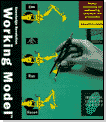Raccolta casi Working Model, visualNastran & SimWise - T-Rex

Contatto Editoriale:
Paolo Lista,
Lista Studio srl®
Borgo Belvigo 33, 36016 Thiene Vi ITALY
tel/fax 0445,372479 o info@lista.it
Simulation software brings a T-Rex to life to take on the terrible waste monster.
This is the story of the birth of the T-Rex - no, not the Jurassic terror that sprang from an egg, but a 1990s robotic waste-drum handler first brought to life on a computer screen by a virtual reality design program.
Thousands of containers of radioactive waste are currently stored above ground at the Radioactive Waste Management Complex of the Idaho National Engineering Laboratory (INEL). The waste containers, which sit on asphalt pads covered by plywood, plastic, and soil, are scheduled to be shipped off-site for permanent disposal beginning in 2003.
While they await shipment, some of the older containers may be deteriorating due to the effects of age, exposure to moisture, and settling soil. Therefore, retrieval of the waste will require some special tools to protect workers and the environment. One such tool is the Tele-Operated Robotic Excavator, or T-Rex, a large excavator that has been altered to perform a variety of hazardous-waste-retrieval functions.
Creating a T-Rex
The T-Rex is the creation of Weldco-Beales of Enumclaw, Washington, which specializes in heavy equipment design and manufacturing. Weldco-Beales was hired to come up with a way to safely retrieve the INEL waste so it can be processed, repackaged, and eventually shipped to a "waste isolation plant" near Carlsban, NM, for permanent disposal.
Designing a device to move the INEL waste posed some unique problems,
according to Richard Helms, senior project engineer and CAD manager at
Weldco-Beales. Among the issues confronting Helms and his colleagues:
* Not all drums that contained the same amount of waste had
the same dimensions or physical characteristics
* Some of the drums were dented or corroded - and were therefore
susceptible to leakage
* To avoid damaging the drums, the loads placed on them during lifting
had to be as small and widely distributed as possible.
"To meet the design criteria, we had to develop a mechanism that had never been seen, tested, or tried in any industry," said Helms. What they eventually came up with is a U-shaped drum handler that can lift drums holding up to 83 gallons waste. The device features three grabber arms: one at the top, one in the middle, and one at the bottom of the U-shaped opening. Each arm wields 60-in. stainless steel straps that loop over the drums.
Lifting the Drums
The plan was to have the remote-controlled excavator approach a drum,
loop the cushioned, flexible straps around it, and pull the straps tight
in a pinching motion designed to minimize pressure on the drums and maximize
the grip of the contact area.
But would things go as planned?
To ensure that they would, Weldco-Beales engineers had to find a way to
see how their design would work in the real world. Would the steel bands
behave properly when looped around the drums?
How much pressure would it take to pick up and hold a fully loaded drum
without damaging it?
What would happen to the shape of the straps when the drum was disengaged?
Due to the urgency of the project, there wasn't time to produce real models of numerous design iterations. Instead, Helms worked with virtual prototypes produced by Working Model, a mechanical simulation design tool developed by Knowledge Revolution of San Mateo, CA.
Virtual Objects
The initial design of the drum handler was created in AutoCAD, then imported into Working Model. In the Working Model world, Helms created a drum handler using virtual "objects" that he endowed with physical properties such as mass, materials, and center of gravity. Then in response to a click on the "run" button, Working Model's simulation engine displayed the drum handler's movements in smooth animation , and at the same time showed motion data in charts and graphs.
Helms watched virtual drum handlers approach a drum, loop straps around it, and tighten the straps. He also ran many what if scenarios, changing the parameters slightly each time, and saved the data after each analysis.
One variable Helms experimented with was the pressure that actuated the flexible straps. After tentatively deciding on a value of 650 psi, he continued to run simulations to test the performance of the straps at that pressure. Working Model confirmed that at 650 psi, the drum handler would move containers without rupturing or dropping any of them.
When the real drum handler was built and tested, it performed " almost exactly as Working Model had predicted," Helms reports. "Without Working Model, we could not have predicted the various motions of the straps, and it would have taken us much longer to predict the actuator forces."
Now the Techno Age T-Rex waits for the command to begin its vital mission: the safe movement of deadly radioactive waste.
